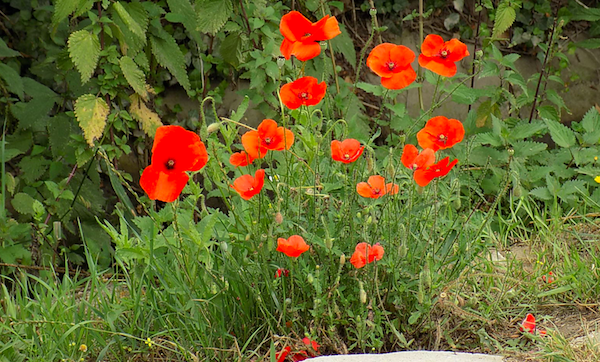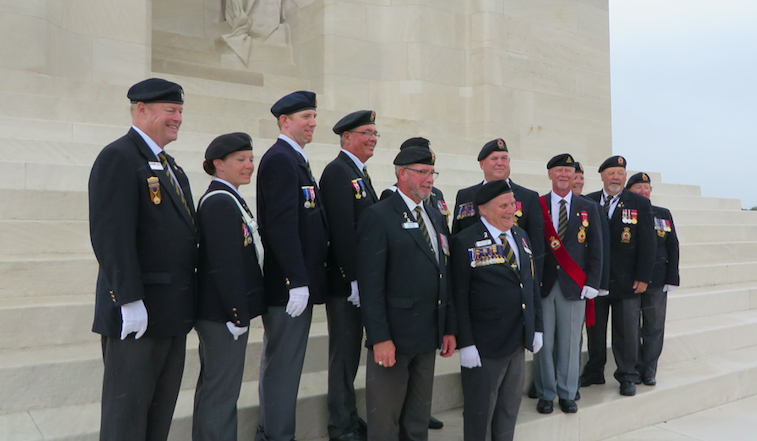By Nujma Bond
Imagine walking in the footsteps of Canadian soldiers who were part of some of the most fierce and significant battles this world has ever seen. Imagine Vimy Ridge, the beaches of Normandy, and other places where conflicts raged across parts of Europe. Sounds, images, and the reality of war came flooding back to over 40 Canadians who spent two weeks this summer on a Pilgrimage of Remembrance, retracing steps, hearing stories and riding an emotional rollercoaster. The sensory experiences could sometimes overwhelm.
“It’s something I’ll never forget,” says Marion Fryday-Cook of Nova Scotia. “I remember more things as I go through the pictures and start crying again. Lots of tears were shed during that trip.”
History has always been intriguing to Fryday-Cook, a teaching assistant in the town of Chester. As the Pilgrimage departure day grew closer, she became more excited, thinking about what she might learn. Nothing could have prepared her for the enormity of what she was about to experience. “I just stood in awe most days,” she says.

Ceremonies of Remembrance took on deep new meaning, held in cemeteries and other places where Canadians found their final resting place. In one instance, the group visited the chilling courtyard of Ardenne Abbey where one by one, captured Canadian soldiers were executed – each reportedly shaking hands with one another before heading behind the abbey to take their last breath. Fryday-Cook remembers the extreme silence and profound emotion of that visit. Other occasions were just as surreal. “You’d be in the middle of nowhere and our guide had a picture of Germans surrendering to the Canadians and you’d look up and you’d be on that same road,” she says.
At Vimy Ridge, the raindrops hit torrentially and fellow pilgrims remarked that at least they weren’t bullets. As they thought about the conditions soldiers had faced, they could not gripe about sloshy footwear, wet hair or drenched clothing.
Buster Rogers of New Brunswick can still visualize Tyne Cot, the largest cemetery for Commonwealth forces in the world. “It was huge,” he says. “I couldn’t believe the enormity of the grounds, row upon row upon row. You just felt empty. Knowing all these people went to war. On a wall were the names of 25,000 people who were never found.”
Even after a quarter-century of reservist experience, Rogers says he didn’t anticipate the range of things he would see an array of emotions he would feel. One day while looking at inscriptions on gravestones he came across one that read, “he’s just away.” The same inscription is engraved on his own brother’s headstone.
Some fields they visited were the sites of battles so fierce it was impossible to locate all the remains. In others, the unexploded ordinance still litters the ground. “I might have been the one to go to war and not return,” Rogers thought as he gazed across battlefields and the magnitude of the past settled in, uncomfortably. “We would look at each other and think about the conditions. This must have been hell.”
A Pilgrimage is born
The Royal Canadian Legion’s Pilgrimage of Remembrance began in 1936 with a visit to Vimy, France for the unveiling of the Canadian National Vimy Memorial. Since then, the Legion regularly leads a group through the historic region with John Goheen, an experienced guide from Port Coquitlam, British Columbia whose own grandfather fought in France. His grandfather returned – missing a leg. During the expedition, Goheen draws upon his vast knowledge of historic and little-known details. This was his eleventh tour and he never tires of it.
“I’m still the last guy in the cemetery, nothing becomes routine about it,” he says, remarking that he feels more at home in these historic places than in many parts of Canada itself. It has become part of his very fabric and not a day goes by that he doesn’t think about what happened in that part of the world.
On this trip, Goheen led pilgrims to over 90 different spots, many of which are rarely visited – by anyone. “It changes people,” he says. “They think differently about who they are, about Canada, about what they’ve got.”
The expedition is an ongoing part of the Legion’s efforts to encourage the remembrance of Canadians whose sacrifices paved the way for the freedoms enjoyed today. This year’s delegation was the largest yet, with 42 people making the journey. Over the years, Veterans, relatives, Legionnaires, teachers, and others have joined the group. Those who make the journey visit some of the most significant and least known spots where events of The First and Second World Wars unfolded. Over 15 days, pilgrims re-live the horror of the trenches of The First World War and the terror of the beaches of Normandy along their trek through Northern France and into Belgium.
Dwane Burke, a teacher from Saskatchewan has a wealth of family history and knowledge about the military and the past. As a younger man, he visited France to see some of the places he had heard about for years. He was in Normandy during the 60th anniversary of D-day. “I did it on my own, I was young,” he says. Burke wanted to visit some of these historic spots again. This time, as a father of two boys, the journey was different. “It’s unspeakable how unbelievable it was,” he says about meeting the other pilgrims, some of whom had ties to people who fought and died in Europe. “Being able to connect through other pilgrims really brought it home.” The Star City history teacher tells the story of one pilgrim whose grandfather was a captain who kept a journal – some of the contents of the captain’s journal were shared on site. Burke recalls it was a pretty incredible way to connect with that time and place.
Merci, merci!
The journey started in France, weaving its way through the regions of Caen and Dieppe, into Ypres in Belgium and ending in the Arras area back in France. As they walked, stopped and contemplated, pilgrims lived through many emotions and felt the extreme gratitude of local residents whose families were liberated all those years ago. The pilgrims recount stories of locals, even children, running up to them and shouting in French, “thanks for our lives,” “thank you for the peace,” and simply, “merci, merci.” The actions of brave Canadians changed the world, and even many years later, the people of France and Belgium have not forgotten.
On one occasion, Buster Rogers recalls a woman who reminded him of Mother Theresa in her frailty. She approached his group asking if they were Canadians. When he replied in the affirmative he says, “she put out her hands and kept saying thank you, thank you, thank you. I reached out and hugged her.”

While visiting Flanders Fields in Belgium, another local woman, much younger, walked up and asked him a question that sticks with him to this day. She said, “can you tell me why all those young people came from your country to die?” It was a common question among pilgrims, the “why?” of it all – but Rogers says they knew. “The tyranny had to be stopped. Had it not stopped the tyranny would have spread.”
Forgotten names
Those who made the journey received the name of a fallen soldier from their home province before leaving. They researched details about the person behind the name. Where they lived, where they died.
Tour guide Goheen explains that it allows pilgrims to connect with the past emotionally and mentally. He taught them how to find all sorts of details such as a soldier’s appearance – the shade of his hair, the colour of his eyes – as a way to understand that these men were just like any of us, but somehow ended up in the middle of the war. Each pilgrim told the story of their soldier right at his gravesite. “It’s a touching moment when you’re standing there and introducing someone,” Goheen says. “Details become more poignant.”
William Thomson, George William Paul, Thomas Choisnet – these were but three of the countless men who lost their lives, their stories resurrected along the pilgrims’ route.
“I may have been the only one to visit William Thomson,” says Dwane Burke with gravity. Thomson enlisted in Prince Albert. He died at Vimy Ridge.
Buster Rogers learned about George William Paul, a private from Saint John, N.B. He was married with no children. Short and slim he sported tattoos and a scar. He was a labourer when he joined. “We walked into the cemetery to his grave and I began my introduction,” he recounts.
Thomas Choisnet of Parrsboro, Nova Scotia was the editor and publisher of a local newspaper says Fryday-Cook. As the stories were told, “we were all a mess,” she says, “what they’d done for us.”
A legacy to share
For some, this pilgrimage brought a kind of closure, a way to bridge the gap of distance and loss by visiting relatives’ resting places. For others, it was a way to personally and viscerally understand the sacrifices made by perfect strangers willing to give their lives for others.
As part of their overall journey, members of the group agreed to share their stories upon returning home. For Fryday-Cook and Burke, there’s an inner urgency to incorporate what they experienced into their classrooms.
“The thing I need to make sure I do is to teach it forward,” says Burke. “Much of what I do is about the importance of Canadian history and the stories. Now I’ll have more stories to share, more feelings to share. We can’t let these stories be lost.”
“I’m really going to start teaching this with the kids in school,” says Fryday-Cook. “We need to keep it alive for them, keep it alive.”
Buster Rogers knows his yearly visit to the Remembrance Day ceremony at a local high school in Saint John will be different this year. He’ll be relaying what he learned. “It’s too big to keep to myself. I have to share it.” As he puts the final touches on his multi-media presentation, he talks about his meeting with officials at CFB Gagetown. He also wants to share his emotional experiences with young cadets in the region.
These pilgrims know first-hand that real-life stories coupled with imagination and remembrance are powerful things.
Note: All citizens can apply to take part in the Pilgrimage of Remembrance which takes place every two years. The next one is scheduled for 2019. Visit Legion.ca to learn more about The Royal Canadian Legion.
Nujma Bond oversees communications at The Royal Canadian Legion Dominion Command. She has led communications departments at several national Canadian organizations and previously was a journalist in Calgary and Regina.

